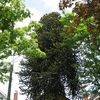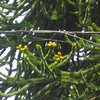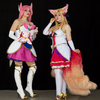The Money-puzzle or Chilean Pine (Araucaria) is native to South America.
It was widely distributed by Captain George Vancouver:
https://en.wikipedia.org/wiki/George_Vancouver
Apparently the seeds are edible and compared to pine nuts.
But the tree doesn't produce them until is 30-40 years old.
Some quotes:
http://vandusengarden.org/explore/vandusen-botanical-garden/plant-collections/tree-month/monkey-puzzle
"This conifer has a pedigree back to the time of the dinosaurs.
Its leathery foliage may have evolved as a deterrent to herbivorous
dinosaurs that in turn may have evolved bigger digestive systems
in order to eat the leaves."
"their straight trunks produce perfect planks"
"The botanical name, Araucaria araucana, is taken from the native
group living where the tree was first spotted by Archibald Menzies,
the naturalist who accompanied Captain George Vancouver on his
great voyage. Menzies was served the seeds of the tree at a dinner
and put some of the almond-sized pods in his pocket. On the voyage
back to England, the seeds sprouted, and the tree later became all
the rage in Victorian England. Older areas of Vancouver settled by
English immigrants are populated with very large monkey puzzle
trees, but they are out of fashion in contemporary small gardens."
"Since Roman times, petrified monkey puzzle tree fossils found
along the Yorkshire coast of England have been made into highly
polished black ornaments and jewelry to ward off evil spirits.
Queen Victoria popularized this stone, called jet, during her
mourning for Prince Albert."
[My apologies for the poor quality of the pictures; they are from 2007]







